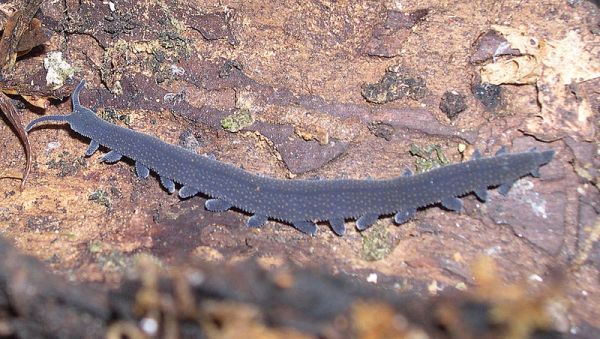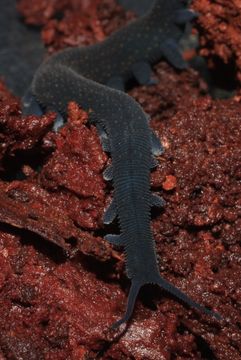 Peripatoides sp., (family Peripatopsidae).
Peripatoides sp., (family Peripatopsidae).photo by Bruno Vellutini, via Wikipedia. Creative Commons Attribution-Share Alike
| Onychophora | ||
| Ecdysozoa | Euonychophora |
| Onychophora | Ecdysozoa | Onychophora
└─► |
||
| Tardigrada | None |
Ecdysozoa | Ecdysozoa | Dinocaridida |
|
Abbreviated Dendrogram
Panarthropoda
├─Aysheaia
└─┬─Tardigrada
│
└─┬─Onychophora
│ ├─Antennacanthopodia
│ └─Euonychophora
│ ├─Helenodora
│ ├─Succinipatopsis
│ ├─Tertiapatus
│ └─┬─Peripatopsidae
│ └─Peripatidae
│ ├─Cretoperipatus
│ └─ Peripatus
╘═Dinocaridida
└─Arthropoda
|
Contents
|
 Peripatoides sp., (family Peripatopsidae).
Peripatoides sp., (family Peripatopsidae).photo by Bruno Vellutini, via Wikipedia. Creative Commons Attribution-Share Alike |
The Onychophora include around 110 described species (and likely a similar number undescribed) of caterpillar-like relatives of arthropods. The first description of a living onychophoran was in 1826 (misinterpreted as a leg-bearing "slug", a mollusc). All living species are terrestrial. They are found in humid habitats, stashing themselves away in burrows or other retreats and becoming inactive during dry periods. During wet periods, they can be found sifting through leaf litter. One particularly unusual aspect of onychophoran behavior is their method of prey capture, which involves shooting twin streams of a rapidly hardening adhesive slime up to 30 cm to entangle their prey. With the exception of just a few species, onychophorans have not been well studied and the New World fauna is especially poorly known. text © Leo Shapiro Creative Commons Attribution Non-Commercial Share Alike
The body itself is not segmented except for the head, which is divided into three segments. The first contains the two large antennae with an eye at the base (Jamaica and South Africa have cave dwelling species which do not have eyes). Some males also have other appendages believed to be involved in sperm transfer. The second segment contains the jaw like mouth which is used for rasping into prey and then sucking out the nutrients. The third segment holds the first pair of parapodia-like legs.
Contemporary onycophorans are ceolomates and have hemocoel, which means they have a lined body cavity filled with blood, rather than a vascular system. They have a muscular tubular heart which pumps the colorless blood around the body cavity. Locomotion is essentially annelid-like, with the body cavity functioning as a hydrostatic skeleton. The parapodia-like legs are also filled with blood and a valve at the base keeps them firm and muscular coordination can extend them or retract them and make them move forward or make them move backward.
On the end of their legs they bear chitinous claws for gripping, although on smooth substrate they walk on walking pads. Onycophorans have a cuticle with α-chitin but lacking collagen, which is periodically shed to permit growth (ecdysis). New cuticle is secreted underneath the old one by the ectodermal cells which develop microvilli that are subsequently withdrawn. Ecdysteroids have been found in various tissues but their function remains unknown (Hoffmann 1997; Nielsen 2001, p. 198). Unlike insect dermis, their cuticle is non-articulated, thin and soft and covered in hundreds of papillae and sensory hairs giving them a velvety texture, hence the common name ‘velvet worm.’
Like insects the Onycophora breathe through spiracles. Spiracles open out to the environment and oxygen enters through a system of tubules (tracheae) and is absorbed into the tissues across the moist surfaces. However, unlike the insects, Onycophora have no control on the spiracles and they are always open, making the animal extremely vulnerable to desiccation, so high levels of humidity are required.
Contemporary Onycophorans are able to predate organisms several times larger than themselves by immobilizing it with a gluey secretion from glands in its head, projected up to 30cm. The secretion holds the prey while the animal approaches it, bites through the cuticle, and injects a toxic, digestive saliva into the wound.
Onychophorans themselves have few predators, except perhaps insect carnivores such as centipedes, birds and rodents. - - Chris Clowes - Peripatatus
All living onychophorans are relatively conservative morphologically. Reconstruction of the stem-group, and erection of successive scions leading down towards the basal node is, however, more difficult, due to the poor fossil record. The Carboniferous Helenodora has been assigned to the Onychophora, but the critical head region is missing. Onychophorans have been described from Tertiary Baltic and Dominican amber, and show that the very short slime papillae and the distinct foot of extant Onychophora are derived crown-group features, as some of the fossils lack them. These Tertiary fossils are likely to lie in the Onychophoran stem group. - Budd 2001
 Euperipatoides rowelli; photo by Andras Kesze Flikr archive, Creative Commons Attribution Non-Commercial Share Alike
Euperipatoides rowelli; photo by Andras Kesze Flikr archive, Creative Commons Attribution Non-Commercial Share Alike |
Euonychophora Phylogenetic definition: here defined as all species closer to .Peripatus (Euonychophora) than to Echiniscus (Tardigrades) or Drosopholia (Arthropoda)
Carboniferous to Recent
Phylogeny: Onychophora : Antennacanthopodia + * : Helenodora + Succinipatopsis + Tertiapatus + (Peripatidae + Peripatopsidae)
Comments: around 10 genera and 110 species recognized within two extant families: the Peripatidae (known from the circumtropical regions of Mexico, Central and northern South America, equatorial West Africa, and South East Asia) and the Peripatopsidae (found in Chile, South Africa, Australia including Tasmania, and New Zealand).Chris Clowes - Peripatatus
Helenodora inopinata Thompson and Jones, 1980
Carboniferous Mazon Creek of northern Illinois
Phylogeny: Euonychophora : Succinipatopsis + Tertiapatus + + (Peripatidae + Peripatopsidae) + *
Comments: Earliest known Euonychophoran
Succinipatopsis balticus Poinar, 2000
Eocene Baltic amber
Phylogeny: Stem group Euonychophora
Tertiapatus dominicanus Poinar, 2000
Eocene Baltic amber
Phylogeny: Stem group Euonychophora
Peripatopsidae Bouvier 1907
Recent
Phylogeny: Euonychophora : Helenodora + Succinipatopsis + Tertiapatus + (Peripatidae + *)
Comments: The Peripatopsidae exhibit relatively many characteristics that are perceived as original or "primitive". They have between 13 and 25 pairs of legs, behind or between the last of which is the genital opening (gonopore). Both oviparous and ovoviviparous, as well as genuinely viviparous, species exist, although the Peripatopsidae essentially lack a placenta. Their distribution is circumaustral, encompassing Australia, Tasmania, New Zealand, New Guinea, South Africa and Chile. - Wikipedia.
Peripatidae Evans 1901
Cretaceous to Recent
Phylogeny: Euonychophora : Helenodora + Succinipatopsis + Tertiapatus + (Peripatopsidae + * : Cretoperipatus + Peripatus)
Comments: The Peripatidae exhibit a range of derivative features. They are longer, on average, than the Peripatopsidae and also have more leg pairs, numbering between 22 and 43—the gonopore is always between the penultimate pair. There are no oviparous species—the overwhelming majority are viviparous. The females of many viviparous species develop a placenta with which to provide the growing embryo with nutrients. Distribution of the Peripatidae is restricted to the tropical and subtropical zones; in particular, they inhabit Central and northern South America, several Caribbean islands, West Africa, northern India, Malaysia and various Indonesian islands. Wikipedia. The only extant family witha fossil record, Cretoperipatus from Cretaceous amber of Burma
Cretoperipatus burmiticus Engel and Grimaldi, 2002
Cretaceous Amber of Kachin state, Myanmar (Burma)
Phylogeny: Peripatidae : Peripatus + *
Comments: Unlike other fossil forms, Cretoperipatus can be assigned to a modern family. But while only five leg pairs can be discerned, the information gained from the fossil is enough to preclude assignment to any known modern genus. (Wikipedia)

Peripatus Guilding 1825
Recent
Phylogeny: Peripatidae : Cretoperipatus + *
Comments: "A widely distributed old-fashioned type of animal, somewhat like a permanent caterpillar. It has affinities both with worms and with insects. It has a velvety skin, minute diamond-like eyes, and short stump-like legs. A defenceless, weaponless animal, it comes out at night, and is said to capture small insects by squirting jets of slime from its mouth." J. Arthur Thomson. 1922. The Outline of Science,
Graphic: from above reference (Public domain, via Wikipedia)
| Onychophora |
page MAK120426